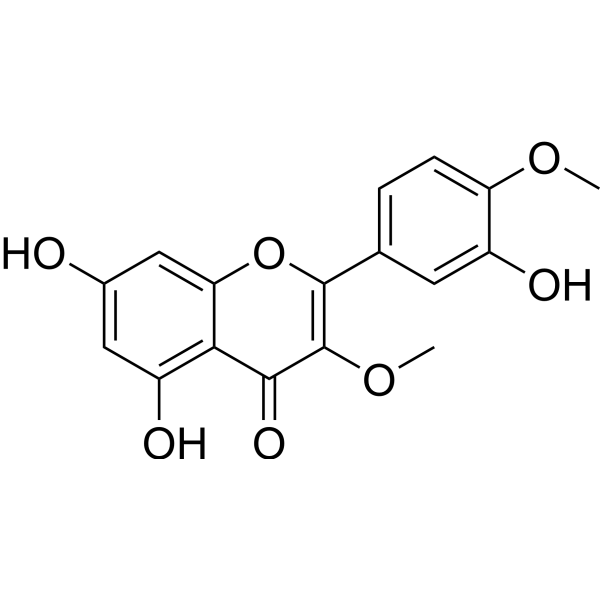
Quercetin 3,4-dimethyl ether
CAS No. 33429-83-3
Quercetin 3,4-dimethyl ether( —— )
Catalog No. M30930 CAS No. 33429-83-3
Quercetin 3,4'-dimethyl ether shows anti-lipid peroxidation activity (IC 50 values of 0.3 uM), it also shows anti-inflammatory activity.
Purity : >98% (HPLC)
 COA
COA
 Datasheet
Datasheet
 HNMR
HNMR
 HPLC
HPLC
 MSDS
MSDS
 Handing Instructions
Handing Instructions
| Size | Price / USD | Stock | Quantity |
| 5MG | 486 | In Stock |


|
| 50MG | Get Quote | In Stock |


|
| 100MG | Get Quote | In Stock |


|
Biological Information
-
Product NameQuercetin 3,4-dimethyl ether
-
NoteResearch use only, not for human use.
-
Brief DescriptionQuercetin 3,4'-dimethyl ether shows anti-lipid peroxidation activity (IC 50 values of 0.3 uM), it also shows anti-inflammatory activity.
-
DescriptionQuercetin 3,4'-dimethyl ether shows anti-lipid peroxidation activity (IC 50 values of 0.3 uM), it also shows anti-inflammatory activity. Quercetin 3,4'-dimethyl ether could be useful in the development of novel anticancer agents, it has high cytotoxic against leukemia cells, it induces cell death is mediated by an intrinsic dependent apoptotic event involving mitochondria and MAPKs, and through a mechanism independent of the generation of reactive oxygen species.
-
In Vitro——
-
In Vivo——
-
Synonyms——
-
PathwayOthers
-
TargetOther Targets
-
Recptor——
-
Research Area——
-
Indication——
Chemical Information
-
CAS Number33429-83-3
-
Formula Weight330.3
-
Molecular FormulaC17H14O7
-
Purity>98% (HPLC)
-
Solubility——
-
SMILES——
-
Chemical Name——
Shipping & Storage Information
-
Storage(-20℃)
-
ShippingWith Ice Pack
-
Stability≥ 2 years
Reference
molnova catalog



related products
-
SP420
SP-420 is a novel orally active iron chelator.
-
RS-127445
RS-127445 is a selective 5-HT2B receptor antagonist with pKi of 9.5 and pIC50 of 10.4, exhibits >1000-fold selectivity against other 5-HT receptors.
-
eukaryotic translati...
eukaryotic translation elongation factor 1 alpha 1 (EEF1A1) (387-394) [Multiple species](TFA) is?Elongation factor 1 subunit.eukaryotic translation elongation factor 1 alpha 1 (EEF1A1) encodes an isoform of the alpha subunit of the elongation factor-1 complex, which is responsible for the enzymatic delivery of aminoacyl tRNAs to the ribosome.



 Cart
Cart
 sales@molnova.com
sales@molnova.com


